|
DISCOVERIES Beaches, bars, churches and curry in no hurry in laid back GoaMiracles and the strange case of the disappearing saint, plus beaches, bars and fun eats from thalis and spicy fish curries to classy pesticos and mojitos in Panaji. by Vijay Verghese 1 January 2024 SEE ALSO Goa resorts guide | Andaman Islands | Bangalore guide | New Delhi Guest Houses | India Spas | Kerala Resorts | Ladakh guide | Mumbai business hotels | Asian resort weddings guide | Rajasthan | Bangkok shopping guide | Phuket resorts review | Bali guide | Hong Kong Guide to Milk Tea | Maldives resorts review 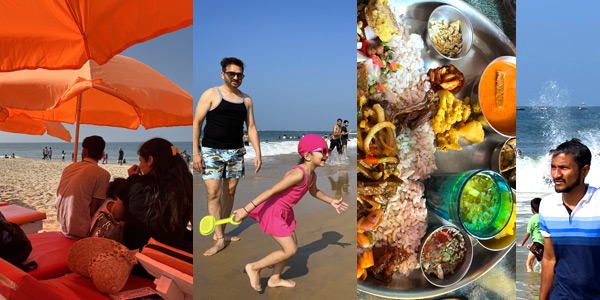
About 45 minutes north of Panjim (Panaji) the broad sands of Calangute beckon, now a family escape rather than a hippie haven - the young and restless have moved to the far north around Arambol; and (second right) colourful Bombil thali for Instagrammers/ photos: Vijay Verghese THE first time I visited Goa in the late Seventies, Calangute, Baga and Anjuna beaches to the north of Panjim (now Panaji) were bustling hippie havens. This pot-smoking chill-out guitar strumming idyll survived for years even under the onslaught of the first 'sex tour' buses packed with tourists from surrounding states who gawped at unclad white flesh and took photos, not furtively, but like paparazzi on a wildebeest shoot with cries of, "Woh nangi hai!" (she's naked) followed by a barrage of clicks and sideways head nods. The local folk didn't care for these anthropological explorations and zealously protected their foreign wards. When I turned up with my American girlfriend — both looking like something the cat dragged in after a long and gruelling train and bus journey from Delhi — fishermen would surround me threateningly if I was alone until she called out to say I was with her. We pitched my small orange plastic tent on the sands and lay there unmoving for days in the blazing muggy heat, fevered, throwing up and running to sand dunes to attend to nature's urgent call every few hours. The steamship cruise back to Mumbai was marginally better (there was nothing left to throw up). The whole experience was traumatising rather than the stuff of heroic travel boasts. MIRACLES AND AIRPORTS Miracles abound. A young lady on my flight from Delhi with a game leg asked for priority boarding, which was granted. Two elderly women arrived on wheelchairs, also with priority access but accompanied by around 12 portly 'foreign-returned' family members who rushed through with them and proceeded to create havoc on the flight re-seating passengers so they could occupy a block together. I was similarly relocated so another 'ill' relative who could barely walk could get my aisle seat. We landed at Panjim's old but upgrading Dabolim Airport (Mormugao, Central Goa) and lo and behold — the lame could walk again, the sick were healed, the cripples cured, and we all rushed out into the tropical sun with joy in our hearts. 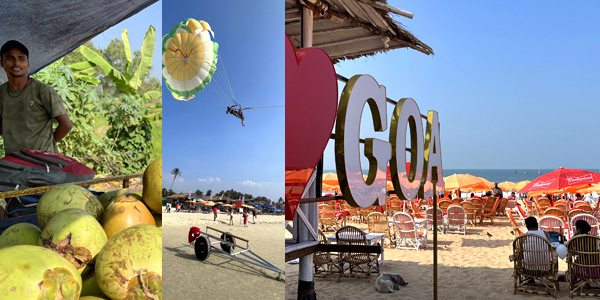
Coconut stalls are everywhere and make for a refreshing stop. Parasailer at Colva Beach an hour south of Panaji and beachfront cafe with panoramic views from higher ground/ photos: Vijay Verghese The newer Manohar International Airport, is an hour-and-a-half drive north from Panaji at Mopa. White tourist taxis (with distinguishing yellow number plates) and private hires are the norm, not the black-and-yellow cabs found elsewhere in India. A one-way taxi hire from Dabolim Airport to Panaji will cost around Rs1,500 (US$1 = 83 Indian rupees). In town, taxis charge about Rs200-Rs300 for short distances with a 15-minute drive from Panjim Church to say the Cidade de Goa Heritage hotel (or the newer neighbouring Cidade de Goa Horizon) costing about Rs700-Rs800. Hotel cabs (operated privately) are likely to charge a little over Rs1,000 for an hour or about Rs2,600 for three hours (depending on kilometres travelled). It is often wise to keep a car though in tourist areas and bar zones, white cabs are quite easily found. Send us your Feedback / Letter to the Editor Local scooter rentals popular in beach areas are around Rs500 per day but, as hospital wards will attest to, driving is not for the faint-hearted or the alcohol infused. Today, access to beaches is better with the help of a fast-developing highway that connects Goa with Mumbai to the north and Bengaluru to the southwest. Once off this artery, though, lanes are immediately narrow and congested and travel times will vary depending on the time and season. GOA BEACHES EXPLAINED The last hippie dives have retreated far north to Arambol (close to the Maharashtra border). The North Goa beaches (in order from Panjim) are Candolim, Calangute, Baga and Anjuna. These are now largely populated by local tourists enjoying the surf with a smattering of Russians and Europeans. These areas abound in low-rent accommodation, beach bars and party hotels. South Goa beaches tend to be less crowded, cleaner with pale yellow or white sand, and dotted with top-drawer international hotel brands (see our earlier Goa resorts review). Colva in the south, about an hour's drive from Panjim (Panaji), is the first beach you'll hit. In this direction you can fork off the highway to access the sand in spots like Varca, Cavelossim, Mobor, Agonda and Palolem (the last two offering greater calm and broad stretches of sand about an hour-and-a-half drive from the capital). In any event, whether you venture north or south, it's pretty much all beach, the only difference being the decibels and the architecture — with more of the finer examples of Portuguese villas in the south. These are all west facing beaches with fine sunsets. 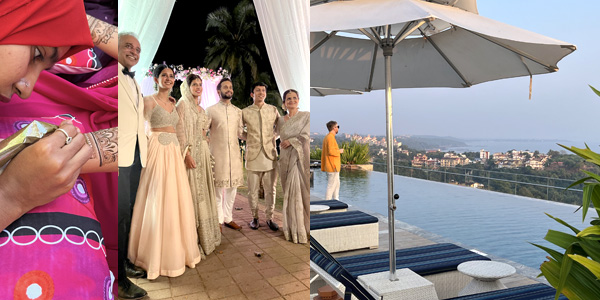
Goa beach weddings are big business. Mehindi hand painting session (left) and bridal party posing at Cidade de Goa Heritage, an excellent beach location 15 minutes from Panjim, and (right) the view from the pool deck - another popular party venue - at the Taj Cidade de Goa Horizon, a newer high-rise building/ photos: Vijay Verghese Miramar Beach is just outside Panaji with Dona Paula Beach (south of the Mandovi River) and Fort Aguada (north of the estuary) a close second. The drive north to local favourite Candolim Beach may take 45 minutes or more due to errant traffic on the narrow roads despite its proximity to Panaji. We battled bus jams, two wheelers and minivans to finally make it to a fine stretch of sand that dips very gradually into the shallow bay. Thatch-roof beach bars like Claudina's dominate the higher ground entrance with nice open views. Unlike say Phuket beaches, Goa sands stretch out fairly straight, up and down the coast so, despite the clutter, it is possible to find a quieter stretch with a bit of legwork. Calangute Beach just a little north, offers a crowded parking lot flanked by tee-shirt and coconut stalls, bars, and cheap lodgings (most offering free WiFi). This is a busier and more touristy beach with orange umbrellas dotting one end and the customary Goa beach clubs dominating the approach. Look for One Calangute Beach Club and the Planet Goa Beach Bar and Restaurant (both to your right as you walk in). These get hopping in the evenings. The broad stretch of sand is clean for the most part with strips of jute carpet 'paving' for those not desirous of getting sand between their toes. There are surprisingly few cultivated fields in the north with coconut trees and some rice fields covering some of the south. Much of the food is imported from surrounding states and the drier terrain (save for during the torrential monsoons) allows for just a single crop during the year. Beautiful functioning churches like Calangute's St Alex Church will pop up everywhere so be prepared to stop your driver and wander in to explore. An hour south of Panjim, Colva Beach is a broad and relatively clean stretch of creamy white sand with an accent on water sports like banana boats, jetboats and parasailing. It is not as noisy as it may sound but when tourists come in the tempo picks up as the occasional wild-eyed person is launched with much flailing of the limbs and shouts to get clear as the speedboat pulls and drags the unfortunate till the parasail fills out and gains altitude. Landings are another frantic affair. 
Dating to 1541, Panjim Church occupies a low hilltop with steps zigzagging down (left); St Alex Church at Calangute (centre) is a fine example of Portuguese Baroque; (right) colourful old villas and chapels in the Old Quarter of Panaji flanking the main church/ photos: Vijay Verghese Nevertheless, visitors seem like satisfied troopers and stagger off amidst much laughter and slaps on the back. With a long shallow incline (reminiscent of Bali's Jimbaran Beach), the receding tides afford much compact glistening sand for bikers and joggers who catch the breezes and some awesome sunsets. At the centre of Goa, half way down the coast, is Panjim (Panaji) with the historic Panjim Church (Our Lady of the Immaculate Conception) that stands stark white and crisply laundered atop a low rise, a cascade of zigzagging steps spilling down to the square flanked by markets and a delightful old quarter lined with well-preserved Portuguese homes in magenta, yellow, blue and green, tiny gardens, hidden churches, ivy-clad walls and bursts of bougainvillea. Panjim Church dates back to 1541 when it got started as a chapel overlooking the city. It grew into its current form over the years, somewhat plain on the outside, like an austere carboard cut-out, but with a Baroque interior. The impressive Basilica of Bom Jesus in Old Goa (about 30 minutes from Panaji) is a much photographed ornately crafted church that dates back to 1605. It houses the much depleted body of St Francis Xavier sans his right forearm that was requested by the Pope in Rome as a worthy relic. Bone fragments from the departed saint found their way to Macau (he died on a mission to China). A toe was reportedly bitten off by a devout worshipper when his body first went on public display. A fingernail is housed in another Goan church, and a hand turned up in Japan. In an era of deep religious faith, this redistribution of body parts was an occupational hazard for celebrity preachers of the time. BARS, CURRY, THALIS, AND PESTICOS Right behind the hill that hosts Panjim Church, along a backwater creek and in the area just north along the banks of the Mandovi River at Fountainhas is a stretch of tiny alleys with small low-rise buildings in the normal jubilant decor, many of these bars, coffee shops or cafes. Here you might try the classy Miguel's — Cocktails and Petiscos, (No.111 Bento Miguel, Old Patto Bridge), a bigger high-ceilinged affair in striking salmon where Portuguese-Konkan fusion is the order of the day. Petiscos is the Portuguese term for tapas. In between classic martinis, margaritas and mojitos, nibble on slow cooked chorizo (locally referred to as Goa sausage), pork vindaloo in puff pastry, ceviche, or deconstructed coconut curry with vegetables. The food is light to filling and imaginatively presented. Expect a central bar with high stools and relaxed seating around the periphery of the room, and excellent service. 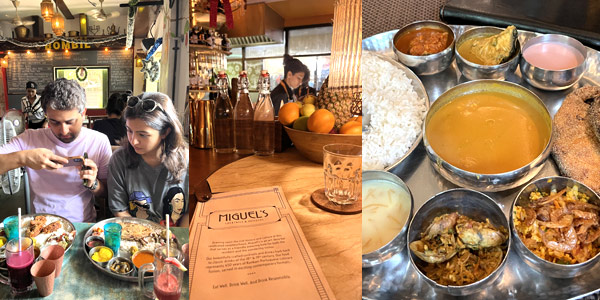
Colourful and quaint Bombil (left) offers flavourful food in Instagrammable surrounds with brisk and friendly service; Miguel's (centre) is a classy bar with fine pesticos (tapas); Foodies flock to the unadorned Ritz Classic for delicious fish curry thalis at various locations around Panjim / photos: Vijay Verghese A short stroll from here down a curving bar alley will bring you to the all blue Antonio (also, Antonio@31 at Rua 31 de Janeiro), a more compact convivial affair with an entrance festooned with colourful ribbons. Interiors are abustle with cocktails and conversations and the atmosphere is relaxed. As is the norm, expect, drinks with nibbles and more substantial eats. Just around the corner is the more local and older Joseph Bar with some outdoor seating. It describes itself as a local feni bar and its signature drink is a potent combination of kokum, feni, and rose. Feni is a clear alcohol derived from cashew apples. A little south, also in the Fountainhas quarter, is the minimalist For the Record — Vinyl Bar, with record jackets and photos of musicians plastered on the walls, smooth cocktails (many feni based), and a high quality vacuum-tube analogue sound system playing vinyl music to get patrons in the mood. Music, munches, and mojitos. Off the riverside road heading towards Miramar Beach is the chic and darkly elegant Black Sheep Bistro housed in an old two-storey bungalow with several nooks and crannies and a vivid selection of art. It is set apart from the road at the end of a well shaded private street with ample parking and a Fabindia store next door. The area is uncrowded and quiet. Sip out in the veranda or dine comfortably indoors. The place does not have typical Goan food but offers its own brand of international fusion. Think ghee roast pork ribs, Hainanese style paneer rice, pulled chicken, mushroom stroganoff and pastas. 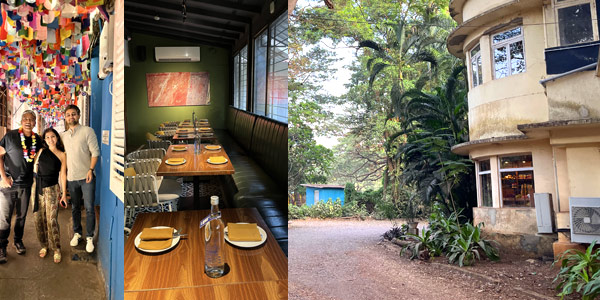
Antonio in all blue with its ribbon ceiling entrance is a fun bar while Black Sheep Bistro (centre and right) offers chic surrounds and international fusion food in an old bungalow littered with art/ photos : Vijay Verghese True Goan curries that will hit you with a blast of hot spice, are to be found at Ritz Classic which, despite its name, is not ritzy at all. It has various locations around town from the Panjim Gymkhana (with outdoor seating too) and the riverside Patto, to the city-centre first-floor Ritz Classic (the entrance tucked into a small alley, 1st floor Wagle Vision, 18th June Rd) not far from Panjim Church. Expect an unadorned diner setup with dark brown Rexine sofas and laid back staff with big smiles and head nods galore. This is neither a place for décor nor decorum. It's for serious foodies. Ritz is a place to roll up your sleeves and dive into the aromatic curries or the signature thalis. Leading the popularity charts is the filling fish curry thali — an absolute steal at Rs314 with two king fish curries, two hefty chunks of pan-fried king fish again, a bowl of kokum with coconut water, fried masala clams, salted fish, a generous serving of delicious prawn curry and a sweet dish. Another excellent choice, this time with an emphasis on quaint Goan décor and good food — that flirts with the palate rather than assails the senses — is the small and cheerful Bombil Restaurant on Dr Braganza Pereira Road. This is a hugely popular place that fills out quickly at mealtimes. Like Ritz it specialises in a fish thali (also thalis featuring semolina-encrusted fried prawn and chilli beef fry). Waiters and waitresses are smiling, knowledgeable and patient with head-scratching diners. Try their fresh fruit juices too. The thalis are flavourful but a tad smaller than at Ritz Classic with fewer offerings but overall this is a truly feel-good place and the atmosphere brings you right into the heart of Goa. While great restaurants are littered around Goa, many in the north (Izumi Asagao for high-end Japanese, Bhatti Village Family Restaurant & Bar (near Candolim Beach), The ASSA House for French, Bomras for Burmese, Pisco by the Beach at Anjuna and Gunpowder for South Indian), Panaji-bound foodies might like to look at Mum's Kitchen (near Black Sheep), Hospedaria Venite, the popular Fisherman's Wharf (next to Bombil), The Hideout Restaurant near Dabolim Airport, and Thalassa (for Greek, also pizza, pasta and good desserts) with outdoor seating in Panaji (Dayanand Bandodkar Marg) and farther north at Siolim beyond Anjuna. The fishermen I encountered this time seemed far more friendly. Perhaps this is because I was staying at a nice hotel and not posing as roadkill outside a small orange tent. I wondered how my fellow travellers, the mysteriously healed family, were doing. I suspected they were playing down the miracles — as they gambolled beach to beach doing cartwheels and back flips — to avoid losing digits to fervent fans. 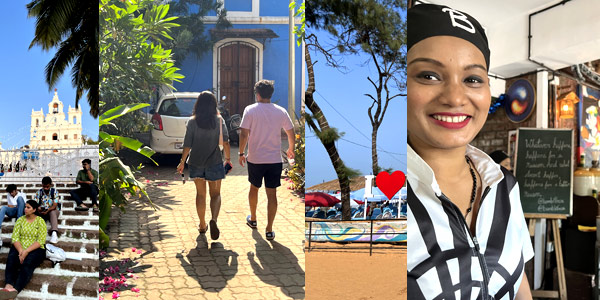
Stately Panjim Church (left); visitors stroll through the old quarter close by with its old Portunguese villas bedecked in flowers and greenery; Calangute beach club; Bombil smiles (right)/ photos: Vijay Verghese
NOTE: Telephone and fax numbers, e-mails, website addresses, rates and other details may change or get dated. Please check with your dealer/agent/service-provider or directly with the parties concerned. SmartTravel Asia accepts no responsibility for any inadvertent inaccuracies in this article. Links to websites are provided for the viewer's convenience. SmartTravel Asia accepts no responsibility for content on linked websites or any viruses or malicious programs that may reside therein. Linked website content is neither vetted nor endorsed by SmartTravelAsia. Please read our Terms & Conditions. |




